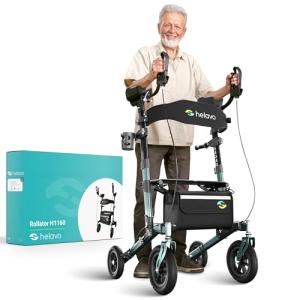9 Lessons Your Parents Teach You About Padded Seat Walker
페이지 정보

본문
The Comprehensive Guide to Padded Seat Walkers: Comfort and Mobility Combined
Mobility challenges belong of life for numerous people, whether due to age, injury, or numerous health conditions. As a solution, the padded seat walker has actually emerged as a popular assistive device that not only aids in mobility but also offers a resting option. This guide will explore the features and benefits of padded seat walkers, some factors to consider for choosing one, and a lot more.
What is a Padded Seat Walker?
A padded seat walker, likewise known as a rolling walker or Rollator Walker, is a wheeled mobility aid geared up with a padded seat for resting. These devices normally have four wheels, handlebars, and a seat that allows users to navigate their surroundings securely while offering a spot to sit and recuperate when required. The walker is especially helpful for individuals who find themselves tired out during extended walking or those who need extra support and stability.
Secret Features of Padded Seat Walkers
Here is an extensive list of essential features to consider when choosing a padded seat walker:
| Feature | Description |
|---|---|
| Padded Seat | Offers convenience during rest, typically with back support to alleviate sitting. |
| Wheels | Usually four wheels for stability and ease of motion, typically with locking systems. |
| Manages | Ergonomic and adjustable handles that deal with different user heights. |
| Brakes | Easy-to-use brake systems that enhance security and control while walking or resting. |
| Storage Options | Frequently consists of a basket or pouch to bring personal items safely. |
| Lightweight Frame | Created for ease of transport and handling, typically made from aluminum or steel. |
| Mobility | Some designs fold up for easy storage and transport, ideal for travel. |
Advantages of Using a Padded Seat Walker
A padded seat walker can substantially enhance the quality of life for users. Here are numerous advantages:
Safety and Stability: A padded seat walker supplies additional support, decreasing the threat of falls and injuries.
Convenience: With a built-in seat, users can take breaks as needed without looking for a place to rest.
Enhanced Mobility: Walkers motivate motion and expedition, promoting independence and encouraging a healthier way of life.
Convenience: Padded seats and ergonomic deals with are developed to supply comfort throughout use, lessening strain on the body.
Easy to use: These walkers are typically easy to utilize with minimal training, making them available for a broad variety of users.
Choosing the Right Padded Seat Walker
When choosing a padded seat walker, consider the following elements:
1. Size and Weight Capacity
It's important to pick a walker that accommodates the user's size and weight. Inspect the weight limits defined by the producer and ensure the walker supplies appropriate stability.
2. Adjustability
Look for designs with adjustable handles to tailor the walker height for convenience and safety. This function is particularly essential for users of varying heights.
3. Seat Height and Comfort
Make sure that the seat height is suitable for the user. A comfortable padded seat with back support will improve the resting experience.
4. Wheel Type
Wheels been available in numerous sizes and designs. Bigger wheels might perform much better on irregular surface areas, while smaller wheels are simpler to maneuver inside your home.
5. Additional Features
Think about additionals such as built-in storage, brake systems, and security features. Advanced models may include devices like cup holders or back-rests.
How to Use a Padded Seat Walker
For maximum benefit and safety, users should know appropriate techniques:
Adjust the Walker: Set the walker to the right height, ensuring that the user can conveniently grip the handlebars while standing directly.
Test Mobility: Before stepping forward, users should guarantee the brakes are disengaged and the walker is stable.
Maintain Posture: Engage core muscles and keep a straight posture while walking. The user must keep their weight centered over the walker.
Take Breaks: If feeling fatigued, the user can stop, engage the brakes, and rest on the padded seat to rest.
Store Items Securely: Place personal belongings in the walker's storage compartment to avoid bring extra weight.
Frequently Asked Questions (FAQ)
Q1: Who can gain from utilizing a padded seat walker?
A1: Padded seat walkers are useful for elderly people, those recovering from surgical treatment, or anyone with mobility concerns who needs support while walking.
Q2: How do I figure out which size walker to get?
A2: Consider the user's height and weight, and inspect the Medical Walker specifications for weight limitations and size suggestions.
Q3: What is the typical lifespan of a padded seat walker?
A3: With appropriate care and maintenance, padded seat walkers can last numerous years, normally between 5 to 10 years.
Q4: Can I use a padded seat walker outdoors?
A4: Yes, lots of padded seat walkers appropriate for outdoor use, provided they have actually appropriate wheels developed for different surface areas.
Q5: How do I preserve a padded seat walker?
A5: Regularly check the brakes and wheels for wear, clean the frame, and guarantee that all parts are working properly for safety.
Last Thoughts
Padded seat walkers represent an important resource in promoting independence and mobility for those facing physical obstacles. By using comfort, stability, and security, they help boost the quality of life for users. If you or a liked one are thinking about a padded seat Portable Walker, this detailed guide ought to assist in making an educated option. Welcoming mobility help can lead to a satisfying and active lifestyle, showing that ease of motion is achievable at any age or condition.

- 이전글The 9 Things Your Parents Taught You About Smart Vacuum Cleaner 25.10.01
- 다음글If Pragmatic Play Slots Catalogue (demo & Real) Is So Bad, Why Don't Statistics Show It? 25.10.01
댓글목록
등록된 댓글이 없습니다.
